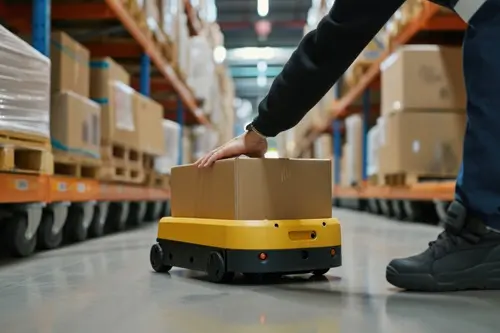Modern Technology in Warehouse Management
Warehouse management has evolved significantly with the advent of modern technology. Today, warehouses are not just storage spaces; they are dynamic hubs that play a critical role in the supply chain. Implementing the right technology can enhance efficiency, accuracy, and productivity. This article explores the various technologies available in transforming modern warehouse management.
1. Warehouse Management Systems (WMS)
A Warehouse Management System (WMS) is a software solution designed to optimize warehouse operations. It manages inventory, tracks shipments, and monitors warehouse activities in real-time. Key benefits include:
- Inventory Accuracy: WMS reduces errors in inventory tracking, ensuring that stock levels are always accurate.
- Improved Efficiency: Automates routine tasks like order picking and packing, reducing the need for manual labor.
- Real-Time Data: Provides real-time visibility into warehouse operations, helping managers make informed decisions.
2. Automated Guided Vehicles (AGVs)
Automated Guided Vehicles (AGVs) are robotic systems used for material handling within warehouses. They follow pre-defined paths and are controlled by software, making them ideal for repetitive tasks. Advantages include:
- Increased Productivity: AGVs can operate 24/7 without breaks, significantly boosting productivity.
- Safety: Reduce the risk of workplace injuries by automating hazardous tasks.
- Cost Savings: Lower labor costs and minimize human errors.
3. Radio Frequency Identification (RFID)
RFID technology uses electromagnetic fields to automatically identify and track tags attached to objects. In warehouses, RFID can streamline various processes:
- Inventory Management: Provides real-time tracking of inventory, reducing the likelihood of stockouts or overstock.
- Speed and Efficiency: Speeds up the receiving and shipping processes by eliminating the need for manual scanning.
- Accuracy: Enhances data accuracy, minimizing errors associated with manual data entry.
4. Internet of Things (IoT) in warehouse management
The Internet of Things (IoT) connects physical devices to the internet, enabling them to collect and share data. In warehouse management, IoT offers several benefits:
- Real-Time Monitoring: Sensors can monitor conditions such as temperature and humidity, ensuring optimal storage conditions.
- Predictive Maintenance: IoT devices can predict when equipment is likely to fail, allowing for proactive maintenance.
- Enhanced Visibility: Provides a comprehensive view of warehouse operations, improving decision-making.
5. Artificial Intelligence (AI) and Machine Learning
AI and Machine Learning are transforming warehouse management by providing advanced analytics and automation capabilities:
- Demand Forecasting: AI algorithms analyze historical data to predict future demand, helping manage inventory more effectively.
- Optimized Routing: Machine learning can optimize picking routes, reducing travel time within the warehouse.
- Automated Decision-Making: AI systems can automate decision-making processes, such as replenishment orders and resource allocation.
6. Robotics and Automation
Robotic systems are increasingly being integrated into warehouse operations to perform tasks such as picking, packing, and sorting:
- Speed: Robots can perform tasks faster than human workers, increasing throughput.
- Consistency: Robots provide consistent performance, reducing the variability in operations.
- Flexibility: Modern robots can be programmed to perform multiple tasks, providing flexibility in operations.
7. Drones for warehouse management
Drones are being used in warehouses for inventory management and inspection:
- Inventory Checks: Drones can quickly and accurately conduct inventory checks, reducing the time and labor required.
- Safety Inspections: Drones can inspect hard-to-reach areas, enhancing safety and compliance.
- Surveillance: Provides an additional layer of security by monitoring warehouse premises.
8. Augmented Reality (AR)
Augmented Reality (AR) technology overlays digital information on the physical world, enhancing warehouse operations:
- Picking Efficiency: AR glasses can guide workers to the correct picking locations, improving accuracy and speed.
- Training: AR can provide interactive training for new employees, reducing training time.
- Maintenance: AR can assist in equipment maintenance by providing visual instructions and diagnostics.
9. Blockchain for warehouse management
Blockchain technology provides a secure and transparent way to record transactions. In warehouse management, blockchain can:
- Enhance Traceability: Provides a transparent and immutable record of inventory movements, improving traceability.
- Reduce Fraud: Blockchain’s security features help prevent fraud and ensure data integrity.
- Streamline Payments: Automates and secures payment processes, reducing transaction times and costs.
10. Cloud Computing
Cloud computing allows businesses to store and access data over the internet, offering several advantages for warehouse management:
- Scalability: Easily scale up or down based on demand, without the need for significant capital investment.
- Accessibility: Access data and applications from anywhere, facilitating remote management.
- Cost Efficiency: Reduces the need for on-site IT infrastructure, lowering operational costs.

Conclusion
Technology plays a pivotal role in modern warehouse management, driving efficiency, accuracy, and productivity. From advanced software systems like WMS to cutting-edge innovations like AI, IoT, and blockchain, these technologies are transforming how warehouses operate. By leveraging these technologies, businesses can optimize their warehouse operations, reduce costs, and improve customer satisfaction.
At 8Stock, we understand the importance of integrating the right technology into your warehouse management processes. Our advanced solutions are designed to help you stay ahead in a competitive market. Request a demo today to see how 8Stock can transform your warehouse management and take your business to the next level.
By following these guidelines and incorporating the above practices, your business can achieve a more streamlined and efficient warehouse management process, ultimately leading to increased profitability and customer satisfaction.

